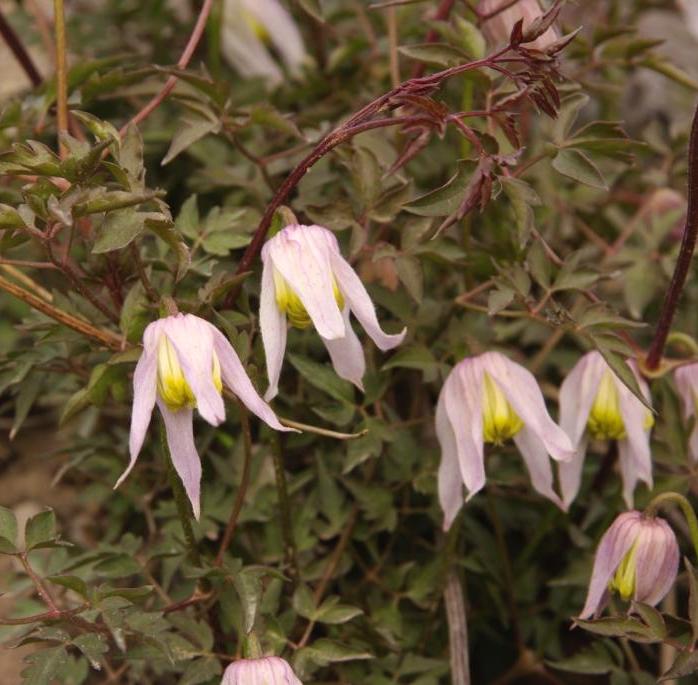Rock Clematis in the Landscape

Stephen Love, University of Idaho
Scientfic Name: Clematis columbianaCommon Name: Rock Clematis, Columbian Virginsbower
Description: Rock clematis is a short, scrambling vine that in nature will clamber over neighboring shrubs and other vegetation. In the garden, it makes an outstanding groundcover or, with support, a short decorative vine. Rock clematis is a variable species that displays a variety of flower colors and vine lengths, and it grows in various habitats. Generally, the plants are deciduous vines less than six feet long (sometimes 10 feet or more); leaves are made up of three leaflets; solitary flowers are produced at the leaf nodes; and the flower color is lavender to blue-violet. Flowers are nodding and have long, narrow, widely separated petals. Rock columbine is moderately drought tolerant and can provide interest in dry shade gardens, or create a vertical element along structures.
Native Habitat: Rock columbine is native to the northwestern states and the southern Rocky Mountains. It usually grows in a variety of heavily vegetated habitats that may include forested slopes, thickets, or dry, brushy hillsides. Habitat elevation ranges from 5,000 to 10,000 feet.
Cultural Requirement
Soil: Prefers a well-drained soil with some organic matter, but will do fine in fairly lean soils. Tolerant of high pH soils.
Moisture Tolerance: Moderately drought tolerant once established, but requires some moisture during the summer months to remain attractive.
Sun/Shade/Preference: Thrives in full sun or part-shade. Grows in fairly heavy shade under trees but will bloom less under these conditions.
Transplanting: Rock clematis can be somewhat challenging to transplant. Only minimal losses occur when transplanting from pot to pot under the controlled-environmental conditions of a greenhouse. Significant losses can occur when transplanting to the garden, especially if the plants are small. Transplanting losses can be reduced by supplying plenty of water during establishment, and protecting plants from wind and sun until new growth is evident. Plants develop fairly slowly and require optimal management to thrive in pot culture. If given good care, they can be produced in pots up to 5-gallon size.
Propagation: Feasible to propagate from seed, although problems that include poor seed germination, seedling damping off, and transplant death, are commonly encountered. Seed requires an undetermined length (3 months should be adequate) of cold-moist stratification. Allow seedlings to develop 3 to 5 true leaves before transferring to larger pots. Vegetative propagation is a good option for rock columbine. Summer softwood cuttings, treated with rooting hormones, can easily be rooted in a mist chamber.
Maintenance (pruning, fertilization, deadheading, division, irrigation, etc): Minimal maintenance is required for rock columbine. Occasional pruning may be needed to shape and train the vines. Infrequent, but deep irrigation will be required to optimize health and appearance. Small amounts of nitrogen fertilizer added in the spring or fall will keep plants vigorous and help produce copious blooms.
Insect, disease, or other problems: Rock columbine has no significant insect or disease pests.
Landscape Value
Use in the Landscape: Rock columbine works well as a groundcover plant, either alone or around taller landscape elements. Makes a nice specimen or accent vine if provided with support.
Foliage: The foliage is deciduous. Leaves are opposite along the vine with each divided into three widely separated leaflets. Vines are slender, supple, and have peeling bark. The vines do not have tendrils, but instead climb by circling support objects and spiraling upward. New vine branches tend to originate at the crown.
Flower: Flowers appear in late spring, usually June. The primary flush of bloom ends in July, but occasional flowers may appear all summer. Flowers are nodding, large (up to 5 inches in diameter), with four petals in shades of lavender, violet, or blue-violet. The flowers are followed by an attractive mop-like, head of silky plumes.
Timing: June-August
Fruit: The fruit is an achene, each with one long, silky plume. Several achenes (seeds) make up each seedhead.
Form: Horizontal or vertical vine.
Texture: Medium.
Ultimate Size: Mature vine length is 5 to 12 feet. Spread depends on training system.
Rate of Growth: Rock columbine plants grow slowly the first year, but develop more rapidly once established. They may bloom sparsely the second year and more numerously in subsequent years.
Suggested Plant Partners:
When used as a ground cover, rock columbine is effective planted by itself. As filler in a dry shade garden, it is best placed among deciduous trees with prominent trunk structure that do not provide a climbing foothold. Examples are Populus tremuloides and Acer grandidentatum. If provided vertical support and trained as a climbing vine, surround the base area with low perennials, such as Phlox kelseyi, Penstemon linarioides, Hymenoxys acaulis, Aquilegia scopulorum, Erigeron glaucus, and Oenothera brachycarpa.
Availability: Occasionally available as potted plants from local or mail-order native plant nurseries. Seed is occasionally offered for sale by native-plant seed suppliers.
Cultivars: None.
References:
Lady Bird Johnson Wildflower Center.Clematis columbiana (Nutt.) Torr. & A. Gray. http://www.wildflower.org/plants/result.php?id_plant=CLCO2. Accessed 28 Oct 2013.
Flora of North America, Vol. 3. Clematis columbiana var. columbiana. http://www.efloras.org/florataxon.aspx?flora_id=1&taxon_id=233500388. Accessed 28 Oct 2

